
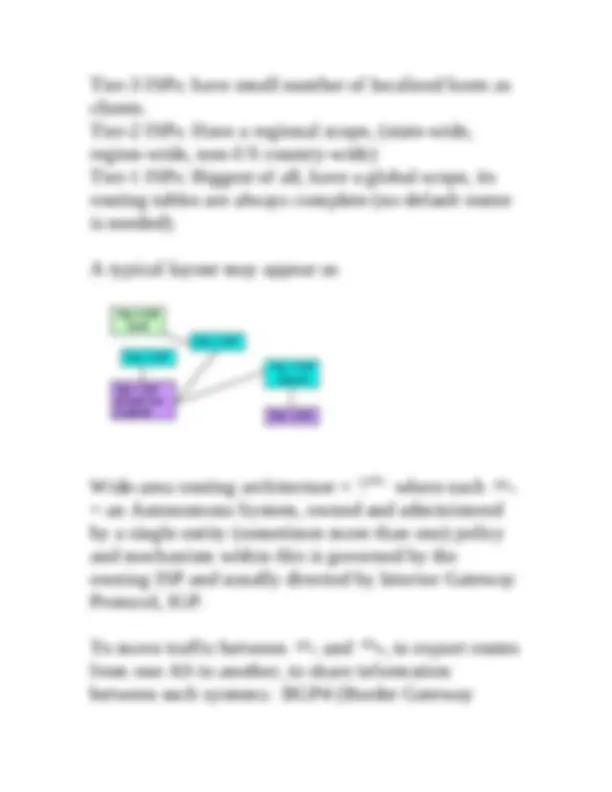
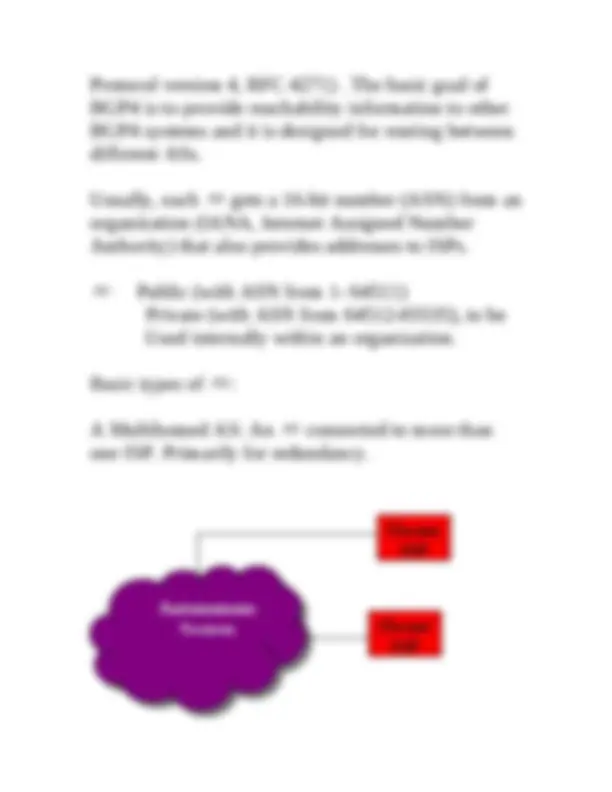
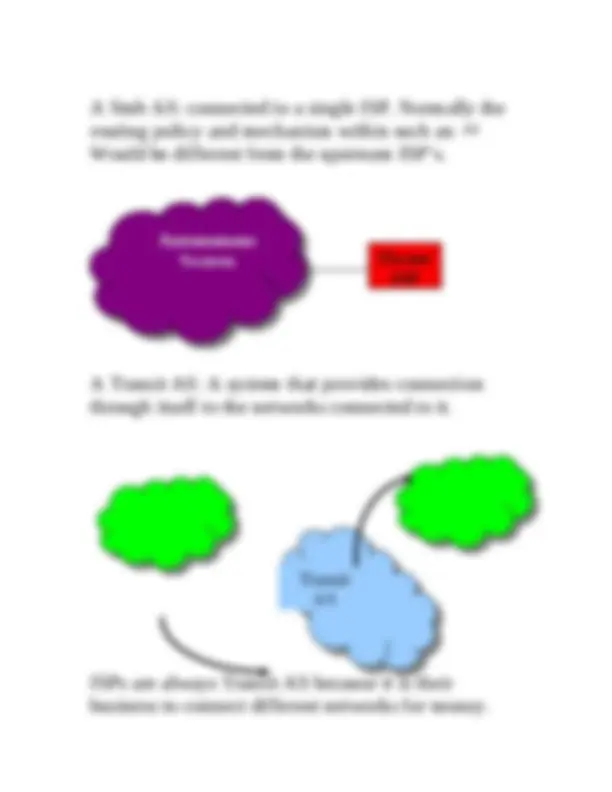
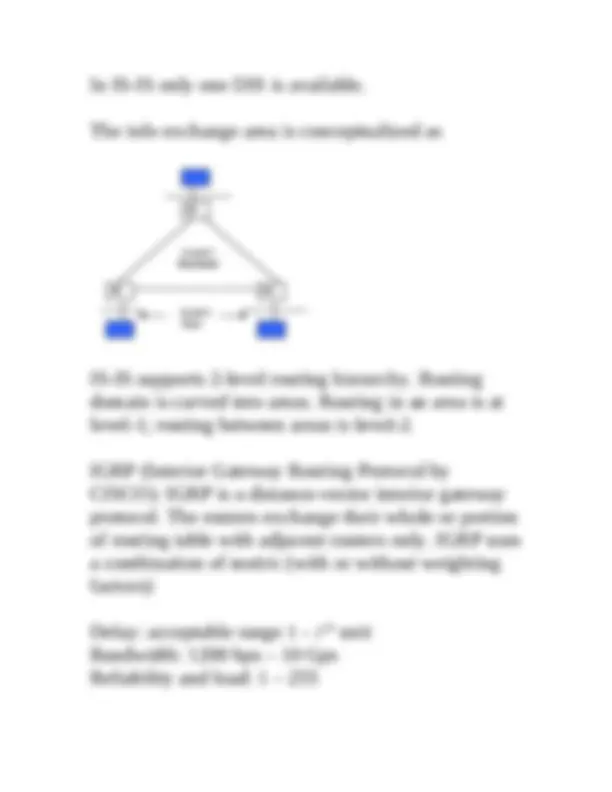
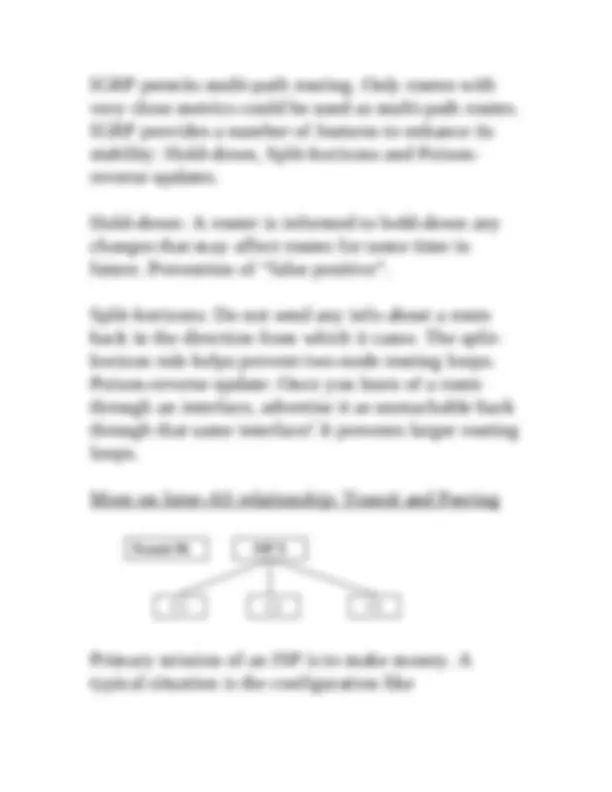

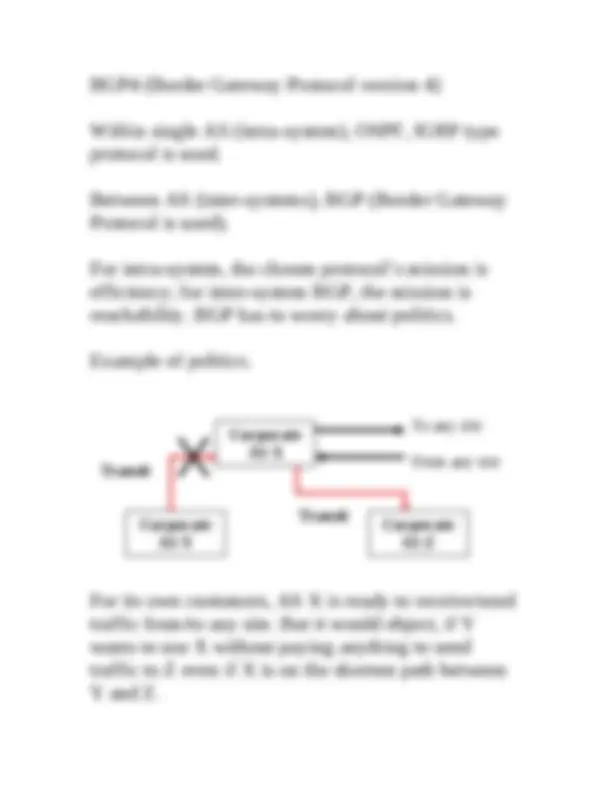
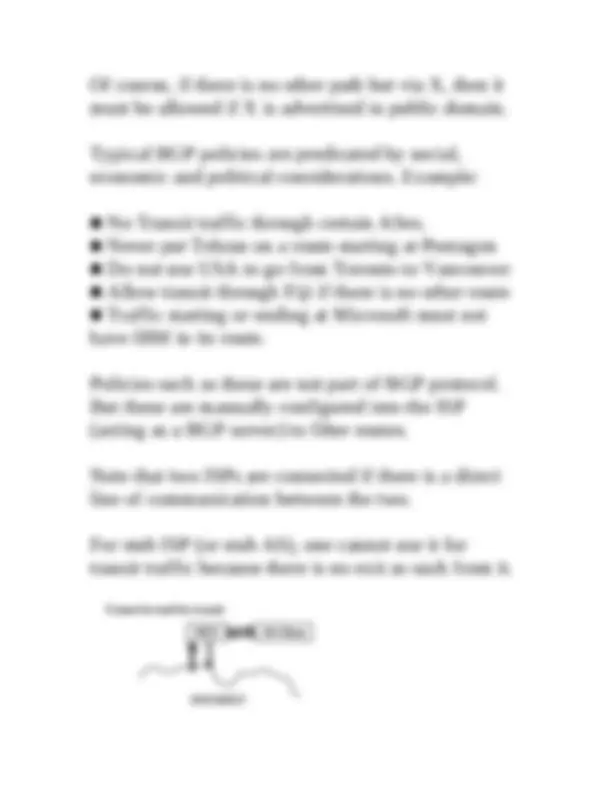
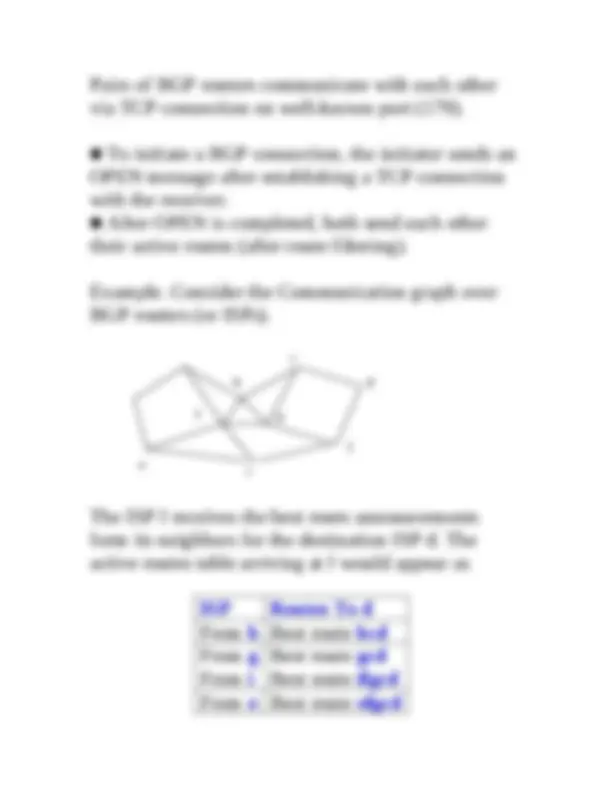
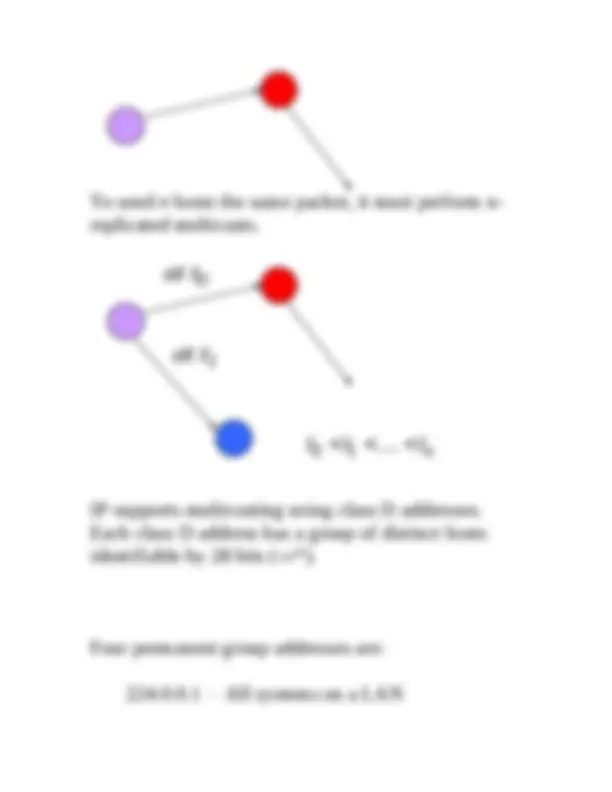

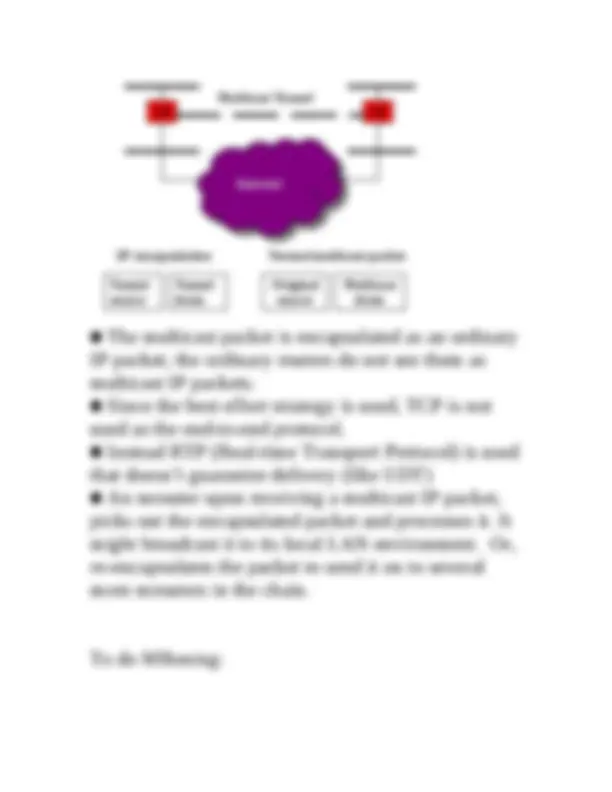
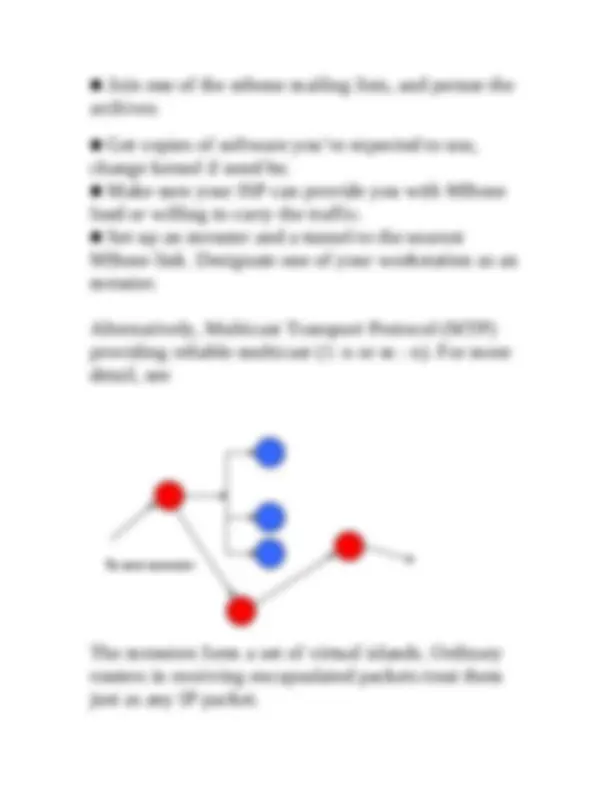
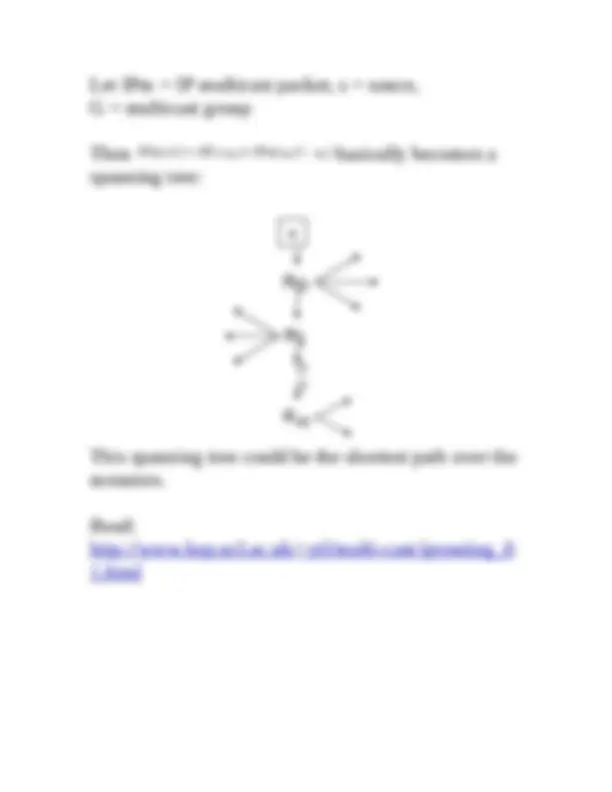


Study with the several resources on Docsity

Earn points by helping other students or get them with a premium plan


Prepare for your exams
Study with the several resources on Docsity

Earn points to download
Earn points by helping other students or get them with a premium plan
Community
Ask the community for help and clear up your study doubts
Discover the best universities in your country according to Docsity users
Free resources
Download our free guides on studying techniques, anxiety management strategies, and thesis advice from Docsity tutors
An overview of wide area internet routing, where end-hosts are served by a community of cooperative peer routers in a fault-tolerant structure. Routers exchange shortest path information and attempt to provide global connectivity, detecting faults and congestion in real-time. The roles of tier-1, tier-2, and tier-3 isps, the use of autonomous systems (as) and interior gateway protocols (igp) like ospf and is-is, and the inter-as relationship through bgp4.
Typology: Study notes
1 / 22

This page cannot be seen from the preview
Don't miss anything!















Wide area Unicast Internet Routing. Focus: ISP. How do they provide service to their customers? How do they exchange routing information among themselves? How do they buy and sell services to each other? An abstract view of Internet. End-hosts are being served by a community of cooperative peer routers in a fault tolerant structure. Routers exchange shortest path info among themselves and attempt to provide global connectivity. Internet routing would detect faults and
congestion in real-time, and the ensemble work collectively to avoid them. A misleading abstraction. Some truth, but mostly myth. Internet service is provided by commercial entities usually in competition to each other. A more realistic abstraction. In this ISPs cooperate to some extent to provide global connectivity to its customers. This architecture implies all ISPs are equal. Not all ISPs are equal. ISP ISP Network
Protocol version 4, RFC 4271). The basic goal of BGP4 is to provide reachability information to other BGP4 systems and it is designed for routing between different ASs. Usually, each AS^ gets a 16-bit number (ASN) from an organization (IANA, Internet Assigned Number Authority) that also provides addresses to ISPs. AS : Public (with ASN from 1- 64511) Private (with ASN from 64512-65535), to be Used internally within an organization. Basic types of AS^ : A Multihomed AS: An AS^ connected to more than one ISP. Primarily for redundancy. Autonomous System Owner ISP Owner ISP
A Stub AS: connected to a single ISP. Normally the routing policy and mechanism within such an AS Would be different from the upstream ISP’s. A Transit AS: A system that provides connection through itself to the networks connected to it. ISPs are always Transit AS because it is their business to connect different networks for money. Autonomous System Owner ISP Transit AS
OSPF is a link-state routing protocol that calls for the sending of link-state advertisements (LSAs) to all other routers within the same hierarchical area. IS-IS (Intermediate System-Intermediate System, RFC 1195): In ISO’s terminology a router is also known as an Intermediate System. IS-IS a Link state protocol similar to OSPF. The latter supports only IP. In IS-IS the routing info exchange is primarily between neighboring routers (Level-1 routers) and among them (hierarchically one level up, Level- routers). Conceptual layout: DIS = Designated Intermediate System In this case Broadcast Link is emulated as virtual node by DIS is also called PseudoNode, PSN. DIS Broadcast Link = PSN PSN
In IS-IS only one DIS is available. The info exchange area is conceptualized as IS-IS supports 2-level routing hierarchy. Routing domain is carved into areas. Routing in an area is at level-1; routing between areas is level-2. IGRP (Interior Gateway Routing Protocol by CISCO): IGRP is a distance-vector interior gateway protocol. The routers exchange their whole or portion of routing table with adjacent routers only. IGRP uses a combination of metric (with or without weighting factors): Delay: acceptable range 1 - 24 (^2) unit Bandwidth: 1200 bps – 10 Gps Reliability and load: 1 – 255 Level- Backbone R R R Level- Area
Here, ISP X provides access to all (or most) destinations in its routing tables for its clients. Clients pay some fees to X. This is a transit relationship. Another relationship is Peering. Interconnection: process of connecting one network to another and transferring some traffic between the two to provide services to end users. Traffic: Voice traffic, IP traffic, Video traffic, etc. Peering is a bilateral business and a technical arrangement where two providers accept the traffic from one another, and from one another’s customers. Peering has no obligation to carry traffic to third parties. Peering always involves a pair of competitors. Idea is that it may not always pay to charge traffics from other sources when they are transiting through you.
Peering usually doesn’t involve any monetary transfer. Normally, it is done when receiving traffic from other AS is about x : y , where x y
. Peering is done under an NDA (Non Disclosure Agreement). An example of peering and transit together. ISP X ISP Z AS 11 AS 22 ISP P ISP G ISP X ISP H Customer set Customer set Customer set Customer set Customer set Transit Transit Transit Transit Transit Peering Peering Transit
BGP4 (Border Gateway Protocol version 4) Within single AS (intra-system), OSPF, IGRP type protocol is used. Between AS (inter-systems), BGP (Border Gateway Protocol is used). For intra-system, the chosen protocol’s mission is efficiency; for inter-system BGP, the mission is reachability. BGP has to worry about politics. Example of politics. For its own customers, AS X is ready to receive/send traffic from/to any site. But it would object, if Y wants to use X without paying anything to send traffic to Z even if X is on the shortest path between Y and Z. Corporate AS X Corporate AS Z Corporate AS Y To any site From any site Transit Transit
Of course, if there is no other path but via X, then it must be allowed if X is advertised in public domain. Typical BGP policies are predicated by social, economic and political considerations. Example: ■ No Transit traffic through certain ASes. ■ Never put Tehran on a route starting at Pentagon ■ Do not use USA to go from Toronto to Vancouver ■ Allow transit through Fiji if there is no other route ■ Traffic starting or ending at Microsoft must not have IBM in its route. Policies such as these are not part of BGP protocol. But these are manually configured into the ISP (acting as a BGP server) to filter routes. Note that two ISPs are connected if there is a direct line of communication between the two. For stub ISP (or stub AS), one cannot use it for transit traffic because there is no exit as such from it. ISP X INTERNET AS Client Cannot be used for transit
The ISP f would discards the paths announced by i and e nodes since they are going through f. From the other two, f must find out which one is faster. Any route that violates the policy of f would automatically be set to an infinite distance away. The BGP4 version solves the count-to-infinity problem easily. See Tanenbaum. In a BGP session, there are two types of messages. One is KEEPALIVE sent to both directions to ensure that the session lasts. Another one, route updates sent during a session if any route entries are changed. Announcements = any change in existing routes, or in new routes. route updates announcement withdrawals
Withdrawals = named routes do not exist any more. Perhaps, the route was damaged. BGP uses TCP; therefore, it provides reliable and in- order delivery. Routes need not be regularly announced unless they are changed. If a KEEPALIVE message fails to arrive from an ISP, all routes through that node must be all damaged. Two types of BGP sessions. BGP session = either an eBGP or an iBGP eBGP ^ session between two BGP speaking routers belonging to different ASes. iBGP ^ when both BGP routers are in the same AS. Both uses the same protocol, but their functions are different. IP Multicasting Most transmissions are logically unicast point-to- point:
224.0.0.2 ^ All routers on a LAN 224.0.0.5 ^ All OSPF routers on a LAN 224.0.0.6 ^ all designated OSPF routers on a LAN Temporary groups must be created first before they are populated. Actual group communication may never be realized in most multicasting cases. One way to achieve IP-multicast is to use the virtual Internet backbone or MBone architecture. MBone comprises special routers that can support multicast traffic (mrouters) over the network and the end-users (they must install mrouters). In an MBone layout, packets are sent from one mrouter to the next mrouter via a tunnel.
■ The multicast packet is encapsulated as an ordinary IP packet; the ordinary routers do not see them as multicast IP packets. ■ Since the best effort strategy is used, TCP is not used as the end-to-end protocol. ■ Instead RTP (Real-time Transport Protocol) is used that doesn’t guarantee delivery (like UDT) ■ An mrouter upon receiving a multicast IP packet, picks out the encapsulated packet and processes it. It might broadcast it to its local LAN environment. Or, re-encapsulates the packet to send it on to several more mrouters in the chain. To do MBoning: M M Multicast Tunnel Internet IP-encapsulation Tunnel source Tunnel destn Normal multicast packet Original source Multicast destn